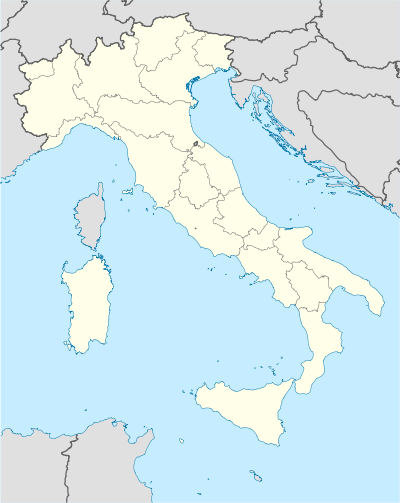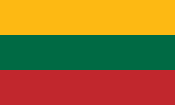Cava de' Tirreni
| Cava de’ Tirreni | |
|---|---|
| — Comune — | |
| Città di Cava de' Tirreni | |
 |
|
 Cava de’ Tirreni
|
|
| Coordinates: | |
| Country | Italy |
| Region | Campania |
| Province | Salerno (SA) |
| Frazioni | see list |
| Government | |
| - Mayor | Marco Galdi |
| Area | |
| - Total | 36.46 km2 (14.1 sq mi) |
| Elevation | 180 m (591 ft) |
| Population (1 April 2009) | |
| - Total | 53,454 |
| - Density | 1,466.1/km2 (3,797.2/sq mi) |
| Demonym | Cavesi |
| Time zone | CET (UTC+1) |
| - Summer (DST) | CEST (UTC+2) |
| Postal code | 84013 |
| Dialing code | 089 |
| Patron saint | Sant' Adiutore end Santa Maria Incoronata dell’Olmo |
| Saint day | September 8 |
| Website | Official website |
Cava de’ Tirreni (also known as Cava dei Tirreni) is a town and comune of Campania, Italy, in the province of Salerno, 10 kilometers NW by rail from the town of Salerno. It lies in a richly cultivated valley, surrounded by wooded hills, and is a favourite tourist resort.
Contents |
Geography
Overview
Cava de' Tirreni is placed very near to the Tyrrhenian Sea, 5 km in the inland at behind the Amalfi Coast, being in practice its north gate. The central built-up area is developed in the valley shaped by the Lattari Mountains (which separates Cava from the Amalfi Coast) at West and by the Picentini Mountains at East. Beisdes, the hills, which surround Cava in every direction, are pleasant residences for a lor of inhabitants.
Cava borders northwards with Nocera Superiore, Roccapiemonte and Mercato San Severino, eastwards with Baronissi, Pellezzano and Salerno, southwards with Vietri sul Mare and Maiori, westwards with Tramonti. The town is a link between the Agro Nocerino Sarnese area (level morphology and agricultural and industrial economy) and the Sorrento and Amalfi Peninsulas (mountainous morphology and economy based on tourism).
Frazioni
Alessia, Annunziata, Arcara, Castagneto, Corpo di Cava, Croce, Dupino, Li Curti, Maddalena, Marini, Passiano, Petrellosa, Pianesi, Pregiato, Rotolo, San Cesareo, San Giuseppe al Pennino, San Giuseppe al Pozzo, San Lorenzo, San Martino, San Nicola, San Pietro a Siepi, Santa Lucia, Santa Maria del Rovo, Sant'Anna, Sant'Arcangelo, Santi Quaranta, Vetranto
History
About two kilometers to the south-west is the village of Corpo di Cava, with the Benedictine abbey of La Trinità della Cava, founded in 1011 by St Alferius. The church and the greater part of the buildings were entirely modernized in 1796. The old Gothic cloisters are preserved.The church contains a fine organ and several ancient sarcophagi. The archives, now national property, include documents and MSS. of great value (e.g. the Codex Legum Longobardorum of 1004, and the La Cava Bible) and fine incunabula.
The appellative de' Tirreni given to Cava is due to the identification, still uncertain, of the territory with the ancient Etruscan town called "Marcina" mentioned by Strabo. The valley was surely inhabited during the Roman Age: the discovery of several archeological relics dating back to that period is an evidence.
At the beginning of the 11th century, an early group of monks got together at the foot of Monte Finestra, attracted by the fame of saintliness of a Longobard noble, Alferio Pappacarbone, who lived there collecting his thoughts in contemplation and prayer. So the Benedictine Abbey of the Holy Trinity was born in 1011 and it became one of the most vivid religious and cultural centres of the South of Italy. The prestige of the saintly men leading the Abbey, together with the need of finding protection, caused the birth of an early residential complex around. In time, thanks to the continuous donations, the possessions of the Abbey increased, while the relative tranquillity of the valley brought to a growth in handicraft and commerce.
The autonomy from abbatial domination was a slow conquest, not free from moments of tension. In 1394, the Pope Boniface IX raised the territory's status to that of a "City", separating Cava from the archdiocese of Salerno and setting it up as diocese directly depending on the Holy See, and entrusted a bishop (that would have been also abbey) with the new diocese. But the Cavesi, who could nt bear the feudal dependence of the Abbey, attacked and devastated it several times between 1335 and 1508, claiming their authonomy. Pope Leo X agreed to their claim and with the Bull "Sincere Devotionis" of the March 22, 1513 set up Cava as autonomous diocese.
Cava had become a prosperous town thanks to the commerce and the industriousness of its inhabitants, who excelled in weaving and in building art. Architects and engineers from Cava worked on the main public and private projects in the South of Italy. Gradually, the centre of the town moved from "Corpo di Cava", walled town close to the Abbey, to "Borgo Scacciaventi", also called lo commerzio ("the commerce", in dialect): the pillars that can still be seen date back to the beginnings of 1400 and are called "Portici" (porticoes). They still represent the centre of Cava de' Tirreni.
A lot of the population lived in the hamlets, some of them hard to reach, and the territory arrived at Cetara (Vietri sul Mare, Cetara and other smaller hamlets seceded from Cava in 1806). People went to Borgo Scacciaventi for commerce and business. The most rich families started building at the Borgo their palaces, traders and artisans built houses on their shops, that grew ahead with the porticoes, in order to protect the goods.
Formerly known as "Città de La Cava", it was theatre of a very important historical event for that time. King Ferdinand of Aragon, who ruled on Naples' territories, felt into an ambush of the Angevins nearby Sarno about in 1460. King Ferdinand of Aragon, who then ruled the territories of Naples, near Foce in area of Sarno, for an incorrect maneuver was surrounded by Angevins. In that occasion was saved by the intervention of men at arms, " salaried " and " conscripts ", the Town of Cava (Cava de 'Tirreni) led by Captains Joshua Longo and Marino, who arrived in the area Foce di Sarno, descended from the mountain and attacked the Angevins. The Angevin army, so surprised and could not determine the extent of the attack, was forced to retire by giving the King Ferdinand giving the opportunity to open the door to Nola and flee to Naples. Grateful for the shown courage and the good turn, the King sent to the mayor Onofrio Scannapieco a Blank Parchment, on which the city could have ask every requirement. The Parchment remained blank and the King conferred upon the whole city the title of Fedelissima ("The Most Loyal"). It is still conserved, untouched and blank as in 1460, in the town hall, and it is the desired price of the annual folk event called Disfida dei Trombonieri.
Economy
The main activity in Cava is the commerce, and it is testified by the lot of quality shops present along the porticoes of the city centre.
In the hamlets, fields under cultivation of fruit and tobacco are present, while, in the industrial estate, there are factories of food, mechanical, textile and furniture products.
City planning
The centre of the valley hosts the main city centre. Here is the ancient "Borgo Scacciaventi", which represented the religious, administrative and commercial heart of the city in the Renaissance. Since the 1950s, it has mainly grew northwards, joining the industrial estate and the nearest hamlets (Passiano, Pregiato and S. Arcangelo). The other hamlets create a half ring and they still keep the features of the ancient "Casali" (Hamlets), living in a slight isolation.

Transportation
Roads and motorways
Cava is crossed by the A3 Motorway Naples-Salerno, belonging to the European route E45.
As regards the national roads, Cava is crossed by the National Road 18 "Lower Thyrrenian" (Strada Statale 18 "Tirrena Inferiore")
Railways
The railway station of Cava de' Tirreni is placed along the Naples-Salerno line, more precisely along the branch that leads to Salerno from Nocera Inferiore and vice versa. This route was used by all the trains before the opening of the new "Santa Lucia gallery", so now the branch is used only by the trains that performs travel service. It allows to reach Salerno in 10–15 minutes, giving the possibility to the travellers of seeing a wonderful panorama of the Cava's valley and of the first kilometres of the Amalfi Coast, thanks to the overhead position of the railway.
The freight yard is nowadays unused, but it still reminds the long industrial tradition of Cava. All regional trains stops in the station, while buses to the Amalfi Coast, Salerno, Sarno, Pompei, Naples and the University of Salerno starts from the square opposite the station.
Urban transport
Public urban and sub-urban transport is performed by CSTP (Consorzio Salernitano Trasporti Pubblici - Salerno Public Transport Association), that links Cava to all the adjoining cities, besides linking it to the several hamlets. Long distance public transport, like the 50 km that separate Cava from Naples and the 25 km that separate it from Amalfi, are performed by SITA. Both SITA and CSTP belong to the "Consorzio Unicocampania", formed of 13 railway and road public transport companies, which serves all the Campania Region with integrated fares.
Great public works
A vehicular underpass is under construction to ease the congestion of the urban tract of the SS18 with the building of an alternative car route for people whose aim is not stop in Cava, but who are only passing through Cava bound for north and south, so that they will not increase the urban traffic.
Sport
The local football team is S.S. Cavese 1919. Its stadium is the "Simonetta Lamberti".
Personalities
|
|
Twin towns - sister cities
Cava de' Tirreni is twinned with:
 Gorzów Wielkopolski, Poland
Gorzów Wielkopolski, Poland Kaunas, Lithuania
Kaunas, Lithuania Pittsfield, USA
Pittsfield, USA Schwerte, Germany
Schwerte, Germany Nesvizh, Belarus
Nesvizh, Belarus
See also
- La Trinità della Cava
References
 This article incorporates text from a publication now in the public domain: Chisholm, Hugh, ed (1911). Encyclopædia Britannica (Eleventh ed.). Cambridge University Press.
This article incorporates text from a publication now in the public domain: Chisholm, Hugh, ed (1911). Encyclopædia Britannica (Eleventh ed.). Cambridge University Press.
- Notes
External links
The town
- "Tuttosucava.it" - All about Cava
- Tuttocava.it
- "Porticando"
- Local Tourist Office of Cava de' Tirreni - "Azienda Autonoma Soggiorno e Turismo di Cava de' Tirreni"
News
- "Il Portico"
- "CavaNotizie"
- "Cavaexplorer" - The portal of Cava de' Tirreni
- "Panorama Tirreno"
- "Il Giornale di Cava"
- "Il Mattino"
Blog
Events
- CavaCultura - Culture, Entertainment and Tourism Quality Department of Cava Town Council
- Annual Balloon Exhibition of Cava
- Disfida dei Trombonieri 2003
- "Festival delle Torri"
- "Pistonieri Santa Maria del Rovo"
- "Associazione Sbandieratori Cavensi"
- "Corale Polifonica Metelliana" - Polyphonic Chorale of Cava
- Cinema schedule
Weather
Religion
|
|||||